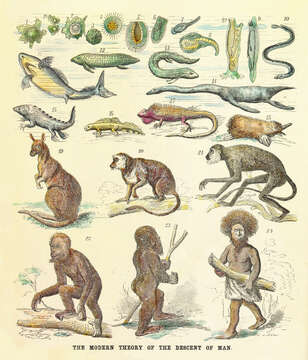Human pidegree

Description:
Description: English: G Avery's opinion of The modern theory of the descent of man, by Ernst Haeckel, published in Anthropogenie oder Entwicklungsgeschichte des Menschen (The Evolution of Man),1874. The figure show the human pedigree as a Great Chain of Being, illustrated by modern and fossil species. Hand-coloured print Legend: 1 Amoeba 1a Asexual reproduction (amoeba dividing) 2 Sexual reproduction (cell with spore) 3 Multi-cellular organism (early embryonic stage) 4 Muliticellular organism with three germ layers (blastula) 5 Organism with primitive mouth (gastrula) 6 Planaria 7 Worm (leech) 8 Primitive chordate (tunicate larva) 8a Adult tunicate 9 Lancelet 10 Jawless fish (lamprey) 11 Cartilaginous fishes (shark) 12 Australian lungfish 13 South American lungfish 14 Aquatic reptile (plesiosaur) 15 Aquatic amphibian (Axolotl) 16 Modern amphibian (newt) 17 Reptile (iguana) 18 Monotreme (platypus) 19 Marsupial (kangaroo) 20 Prosimian (lemur) 21 Monkey (langur) 22 Ape (orangutan) 23 Ape-man (Pithecanthropus) 24 Modern human (a Papuan). Date: 11 March 1876. Source: Scientific American. Author: G Avery.
Included On The Following Pages:
- Life (creatures)
- Cellular (cellular organisms)
- Eukaryota (eukaryotes)
- Amoebozoa (amoeboid protists)
- Tubulinea
- Elardia
- Euamoebida
- Amoebidae
- Amoeba
This image is not featured in any collections.
Source Information
- license
- cc-publicdomain
- creator
- G Avery
- source
- Scientific American
- original
- original media file
- visit source
- partner site
- Wikimedia Commons
- ID


